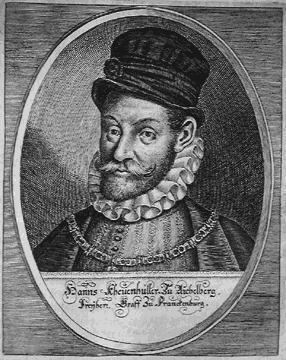Style(s) Serene Highness | Founded 14th century | |
 | ||
Titles Freiherren (1566)
Imperial Counts (Reichsgrafen) of Khevenhüller-Frankenburg (1593)
Imperial Counts of Khevenhüller-Hochosterwitz (1725)
Princes of Khevenhüller-Metsch (1763) Current head Johannes Khevenhüller-Metsch | ||
Khevenh ller marsch
Khevenhüller is the name of a Carinthian noble family, documented there since 1356, with its ancestral seat at Landskron Castle. In the 16th century, the family split into the two branches of Khevenhüller-Frankenburg, Imperial Counts (i.e. immediate counts of the Holy Roman Empire) from 1593, and Khevenhüller-Hochosterwitz, raised to Imperial Counts in 1725 and, as Khevenhüller-Metsch, to princely rank (Fürsten) in1763.
Contents
- Khevenh ller marsch
- sterreichischer milit rmarsch khevenh ller festmarsch
- History
- Christoph Khevenhller
- Hans Khevenhller
- Bartlm Khevenhller
- Paul Khevenhller
- Notable members of the House of Khevenhller
- Princes of Khevenhller Metsch
- Actual Head of the Khevenhller Metsch Family
- Spanish branch
- References
In the present-day Austrian state of Carinthia, the princely family of Khevenhüller-Metsch owns the Renaissance castle of Hochosterwitz, a significant edifice and major tourist attraction.
sterreichischer milit rmarsch khevenh ller festmarsch
History
The noble family originally possibly originated in Kevenhüll (today part of Beilngries) in Franconia; they were vassals of the Bishops of Bamberg, who had received large estates in Carinthia from the hands of King Henry II of Germany in 1007. The earliest mention refers to one Ulreich dem Chevenhuelaer in a 1330 deed. In Carinthia, an continuous line descends from one Johann I (Hans) Khevenhüller, who died in 1356 and was the son-in-law of Richard I von Khünburg and Elisabeth von Himmelberg, both from Carinthia.
Johann IV von Khevenhüller zu Aichelberg (born ca 1420-1462) was the first to hold the family title "of Aichelberg", yet Johann V Khevenhüller (died 1462), son of Wilhelm II Khevenhüller and Margareta von Auersperg, was Burgrave of Federaun, whereas his son, Augustin Khevenhüller, who died 1516, is referred to as Herr (i.e. Lord) of Hardegg. His mother was one "Miss" von Lindegg, who together with her grandson Sigismund III, Herr Khevenhüller in Hohen-Osterwitz (1507–1558) appears among the ancestors of Prince Charles. Her youngest grandson, Bernard von Khevenhüller (1511–1548) was "Herr auf Sternberg and Hohenwart"; her eldest grandson, Christoph Khevenhüller (1503–1557) was Lord of Aichelberg.
Christoph Khevenhüller
The steep rise of the House of Khevenhüller in Carinthia began when in 1525 Christoph Khevenhüller (1503 -1557) was appointed castellan of Ortenburg Castle near Spittal an der Drau and married a wealthy burgher's daughter, Elizabeth Mansdorfer. Her wealth enabled him to acquire a number of properties in Carinthia such as the castles of Aichelberg, Ortenburg, Sommeregg, Hochosterwitz and Landskron as well as the iron mine of Eisentratten near Gmünd. Like the majority of the Carinthian Estates Christoph Khevenhüller became a Lutheran Protestant. Of Christoph Khevenhüller's s three sons, Hans, Moritz and Bartlmä, two were politically and economically most successful, thus furthering the rise of the family:
Hans Khevenhüller
Hans Khevenhüller (1538–1606) became the Legate of the Holy Roman Emperor at the Spanish court, an office that he held for 26 years. He was appointed Imperial Chamberlain, was made a Knight of the Order of the Golden Fleece in 1587 and a count in 1593, a rank that upon his death passed on to his brother Bartlmä.
Bartlmä Khevenhüller
The activities of Bartlmä Khevenhüller (1539–1613) centred on Carinthia. Styling himself "Freiherr auf Landskron and Wernberg" he made it to Burggrave und Speaker of the Estates, and managed to make the Khevenhüller family one of the wealthiest in the German Reich. He also figured as the head of the Protestants in Carinthia.
When in the course of the counter-reformation Emperor Ferdinand II abolished the nobility's religious freedom in the Habsburg lands, the Protestant members of the Khevenhüller family were forced to abandon their possessions in Carinthia and emigrated to Germany in 1628. Among these was also the great-grandmother of Nicolaus Ludwig Reichsgraf von Zinzendorf und Pottendorf of the Moravian Church or Herrnhuter Brüdergemeine. Interrelation with the noble Saxonian Metzsch family began that led to the Khevenhüller-Metsch branch, which later also spread to Spain where as marquesses and dukes they became Grandees of Spain.
Paul Khevenhüller
Being a Protestant Paul Khevenhüller (1593–1655) sided with the Swedish king during the Thirty Years' War lending Gustav Adolf 70 000 Swedish riksdalers to finance the war. After the king's death the Swedish state was incapable of repaying the loan and compensated the lender with the property of Julita Gård in Södermanland, which remained the residence of his descendants late into the 19th century.
